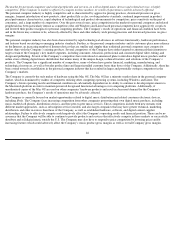Apple 2005 Annual Report Download - page 54
Download and view the complete annual report
Please find page 54 of the 2005 Apple annual report below. You can navigate through the pages in the report by either clicking on the pages listed below, or by using the keyword search tool below to find specific information within the annual report.
The Company’s business relies on access to patents and intellectual property obtained from third parties, and the Company’s future results
could be adversely affected if it is alleged or found to have infringed on the intellectual property rights of others.
Many of the Company’s products are designed to include intellectual property obtained from third parties. While it may be necessary in the
future to seek or renew licenses relating to various aspects of its products and business methods, the Company believes that based upon past
experience and industry practice, such licenses generally could be obtained on commercially reasonable terms. However, there can be no
assurance that the necessary licenses would be available or available on acceptable terms.
Because of technological changes in the computer and consumer electronics industries, current extensive patent coverage, and the rapid rate of
issuance of new patents, it is possible certain components of the Company’
s products and business methods may unknowingly infringe existing
patents of others. The Company has from time to time been notified that it may be infringing certain patents or other intellectual property rights
of others. Responding to such claims, regardless of their merit, can be time-consuming, result in significant expenses, and cause the diversion
of management and technical personnel. Several pending claims are in various stages of evaluation. The Company may consider the
desirability of entering into licensing agreements in certain of these cases. However, no assurance can be given that such licenses can be
obtained on acceptable terms or that litigation will not occur. In the event there is a temporary or permanent injunction entered prohibiting the
Company from marketing or selling certain of its products or a successful claim of infringement against the Company requiring it to pay
royalties to a third-party, the Company’s future operating results and financial condition could be adversely affected. Information regarding
certain claims and litigation involving the Company related to alleged patent infringement and other matters is set forth in Part I, Item 3 of this
Form 10-K. In the opinion of management, the Company does not have a potential liability for damages or royalties from any current legal
proceedings or claims related to the infringement of patent or other intellectual property rights of others that would individually or in the
aggregate have a material adverse effect on its results of operations, or financial condition. However, the results of such legal proceedings
cannot be predicted with certainty. Should the Company fail to prevail in any of the matters related to infringement of patent or other
intellectual property rights of others described in Part I, Item 3 of this Form 10-K or should several of these matters be resolved against the
Company in the same reporting period, the operating results of a particular reporting period could be materially adversely affected.
The Company’s retail initiative has required and will continue to require a substantial investment and commitment of resources and is subject
to numerous risks and uncertainties.
Through October 2005, the Company had opened 126 retail stores. The Company’s retail initiative has required substantial investment in
equipment and leasehold improvements, information systems, inventory, and personnel. The Company has also entered into substantial
operating lease commitments for retail space with lease terms ranging from 5 to 20 years, the majority of which are for 10 years. The Company
could incur substantial costs should it choose to terminate this initiative or close individual stores. Such costs could adversely affect the
Company’s results of operations and financial condition. Additionally, a relatively high proportion of the Retail segment’s costs are fixed
because of depreciation on store construction costs and lease expense. As a result, significant losses would result should the Retail segment
experience a significant decline in sales for any reason.
Certain of the Company’s stores have been designed and built to serve as high profile venues that function as vehicles for general corporate
marketing, corporate events, and brand awareness. Because of their unique design elements, locations and size, these stores require
substantially more investment in equipment and leasehold improvements than the Company’s more typical retail stores. The Company has
opened seven such stores through October 2005. Because of their location and size, these high profile stores also require the Company to enter
into substantially larger operating lease commitments compared to those required for its more typical stores. Current leases on such locations
have terms ranging from 10 to 14 years with total
52
























